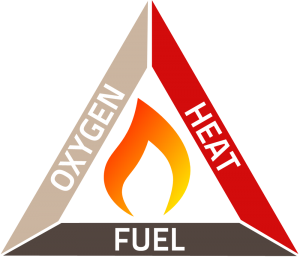Back to Basics with the Fire Triangle
Trying to understand the seemingly endless list of fire safety regulations can be a complex and confusing task. Whether you are attempting to identify the different types of fire extinguisher and their appropriate uses or are learning about the benefits of a fire blanket, it is vital to remember that the various stringent rules are there for a reason and this reason ultimately relates to the fire triangle.

Something usually taught in school, the fire triangle (which is also known as the combustion triangle) is a simple model for understanding the chemical reaction which must occur to create a fire. It is composed of three elements – fuel, heat and oxygen – which must all be present for a fire to ignite. It also demonstrates the interdependence of these ingredients in creating and sustaining a fire and teaches us that removing any one of these elements would prevent or extinguish the fire.
The fire triangle is often used as a basic form of fire safety training and looks at the dynamics of fire itself. By looking at and understanding this in more detail, it is much easier to grasp the need for, and details of, fundamental fire regulations – so let’s get back to basics…
Fuel
In order for a fire to start there must be a material to burn – and this is referred to as the fuel. Fuel is any kind of combustible material, including paper, oils, wood, gases, fabrics, liquids, plastics and rubber. The fuel for a fire is usually characterised by its moisture content, size, shape and quantity and this will determine how easily the fuel will burn and at what temperature.
Heat
In addition to a fuel source, heat must be present in order for ignition to take place. All flammable materials give off flammable vapours which, when heat is present, combust. Heat is also responsible for the spread and maintenance of fire as it removes the moisture from nearby fuel, warming the surrounding area and pre-heating fuel in its path, enabling it to travel and develop with greater ease.
Oxygen
As well as fuel and heat, fires also need oxygen to stay alight. Ambient air is made up of approximately 21% oxygen and, as most fires only require at least 16% oxygen to burn, it acts as the oxidising agent in the chemical reaction. This means that when the fuel burns, it reacts with the oxygen to release heat and generate combustion.
Extinction of the fire
To stop a fire, one of the three elements of the fire triangle must be removed. So, if a fire runs out of fuel, it will smoulder out; if you can cool a fire down it will lose heat and go out; and if the oxygen is removed it will suffocate. Therefore, attempts at combatting a fire and also preventing a fire are based upon these principles. Fire blankets, for example, suppress a fire, removing the oxygen and, as a result, putting it out. Similarly, fire extinguishers are developed to eliminate one of the three elements – such as water fire extinguishers which cool the fire down and remove any heat.
By the same codes of practice, fire prevention methods are also developed in relation to the chemical reaction which occurs when fire takes place. Undertaking safety steps such as storing flammable liquids away and making sure piles of paper or fabric are not left near any possible heat sources are highly important.
By using this fundamental fire safety knowledge, the prevalence of fires and the damage they cause can be significantly reduced.
Request a Callback
Just fill in your details below and we'll get back to you as soon as we can!

About Scutum London
Scutum London is a leading expert in fire safety and security solutions for businesses and organisations located across South East England, including London and Surrey.
From fire alarms, fire extinguishers and fire risk assessments to access control, CCTV and intruder alarm systems – and a lot more besides – we offer a comprehensive range of products and services designed to keep you, your business and your staff and visitors safe.
With decades of industry experience to call on, we’re proud to hold accreditations from leading trade associations and bodies such as British Approvals for Fire Equipment (BAFE), the British Fire Consortium, the Fire Industry Association (FIA) and Security Systems and Alarms Inspection Board (SSAIB).
If you’d like to find out more about Scutum London, get in touch with our friendly team or explore our products and services on our site.

